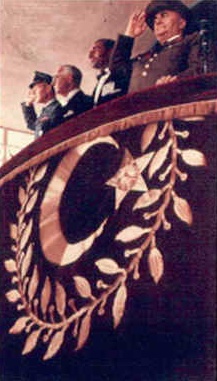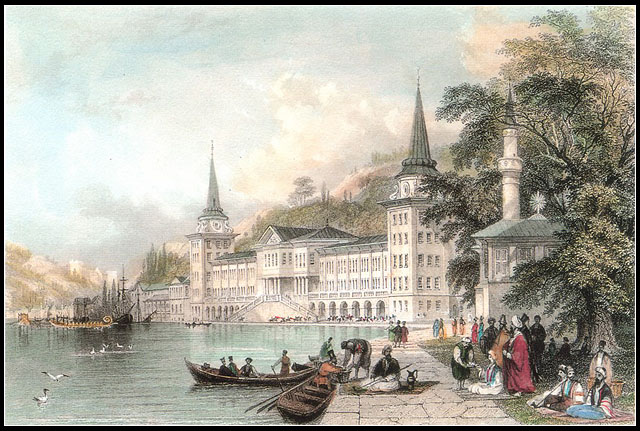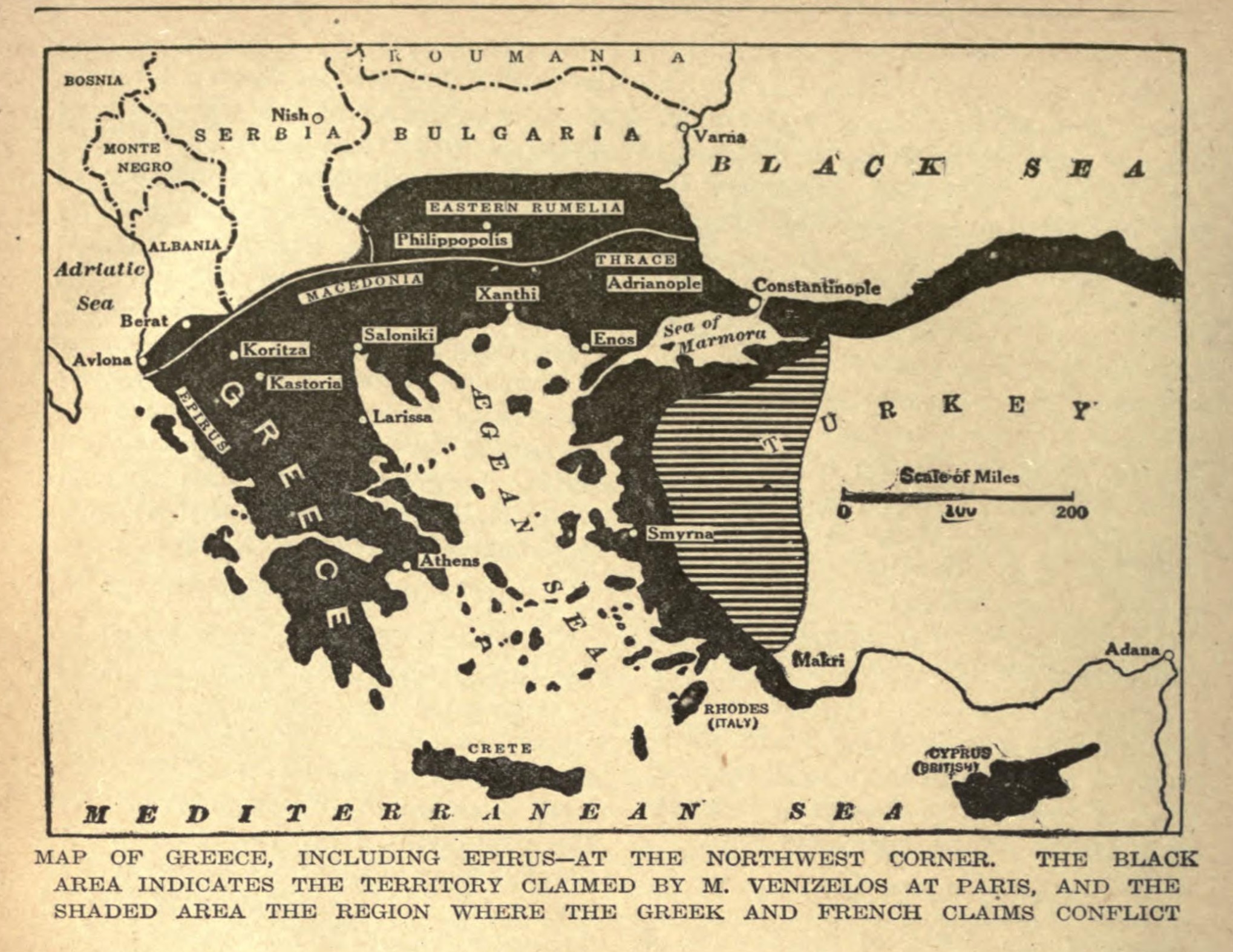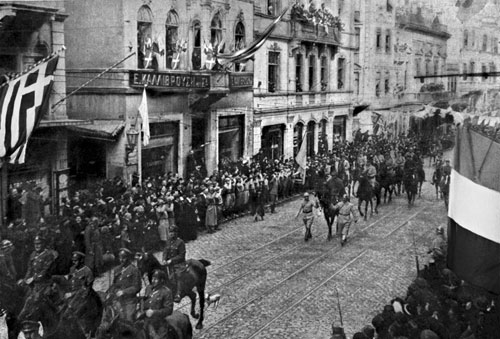|
Cemal Gürsel
Cemal Gürsel (9 June 1894 – 14 September 1966) was a Turkish military officer and politician who was the fourth president of Turkey, serving from 1960 to 1966 after taking power in a coup d'état. Early life Gürsel was born in the town of Hınıs in the Erzurum Vilayet as the son of an Ottoman Army officer, Abidin Bey, and the grandson of Ibrahim (1821–1895) and the great-grandson of Hadji Ahmed (1788–1860). After the elementary school in Ordu and the military middle school in Erzincan, he graduated from the Kuleli military high school in Istanbul. He was a popular figure and was therefore nicknamed "Cemal Ağa" (Cemal the Big Fellow) since his childhood school years and onwards all his life. Gürsel served in the Army for 45 years. During World War I, he participated in the Battle of Çanakkale in Dardanelles, Gallipoli as a lieutenant with the First Battery of the 12th Artillery Regiment in 1915 and received the War Medal. He later fought at the Palestine and S ... [...More Info...] [...Related Items...] OR: [Wikipedia] [Google] [Baidu] |
President Of Turkey
The president of Turkey, officially the president of the Republic of Türkiye (), is the head of state and head of government of Turkey. The president directs the executive branch of the national government and is the commander-in-chief of the Turkish military. The president also heads the National Security Council. The office of the president of Turkey was established with the proclamation of the Republic of Türkiye on 29 October 1923, with the first president and founder being Mustafa Kemal Atatürk. Traditionally, the presidency was mostly a ceremonial position, with real executive authority being exercised by the prime minister of Turkey. However, constitutional amendments approved in the 2017 constitutional referendum abolished the office of prime minister, and vested the presidency with full executive powers, effective upon the 2018 general election. The president is directly elected by eligible Turkish voters for a five-year term. The president of Turkey is referr ... [...More Info...] [...Related Items...] OR: [Wikipedia] [Google] [Baidu] |
World War I
World War I or the First World War (28 July 1914 – 11 November 1918), also known as the Great War, was a World war, global conflict between two coalitions: the Allies of World War I, Allies (or Entente) and the Central Powers. Fighting took place mainly in European theatre of World War I, Europe and the Middle Eastern theatre of World War I, Middle East, as well as in parts of African theatre of World War I, Africa and the Asian and Pacific theatre of World War I, Asia-Pacific, and in Europe was characterised by trench warfare; the widespread use of Artillery of World War I, artillery, machine guns, and Chemical weapons in World War I, chemical weapons (gas); and the introductions of Tanks in World War I, tanks and Aviation in World War I, aircraft. World War I was one of the List of wars by death toll, deadliest conflicts in history, resulting in an estimated World War I casualties, 10 million military dead and more than 20 million wounded, plus some 10 million civilian de ... [...More Info...] [...Related Items...] OR: [Wikipedia] [Google] [Baidu] |
Turkish Military Academy
The Turkish Military Academy () or as it is known historically and popularly Harbiye is a four-year co-educational military academy and part of the National Defense University (Turkey), National Defence University. It is located in the center of Ankara, Turkey. Its mission is to develop cadets mentally and physically for service as commissioned officers in the Turkish Army, and is the oldest of the academies of the Armed Forces (opened 1834). After the 2016 Turkish coup d'état attempt, 2016 coup d'état attempt, the Military Academy (along with the Turkish Naval Academy, Naval Academy, the Turkish Air Force Academy, Air Force Academy and all the other military educational institutions) became part of the new National Defense University (Turkey), National Defence University, which was formed under the Ministry of National Defense (Turkey), Ministry of National Defence. History On 15 June 1826, Sultan Mahmud II Auspicious Incident, abolished the Janissary Corps, which had ... [...More Info...] [...Related Items...] OR: [Wikipedia] [Google] [Baidu] |
Kuleli Military High School
Kuleli Military High School was the oldest military high school in Turkey, located in Çengelköy, Istanbul, on the Asian shore of the Bosphorus strait. It was founded on 21 September 1845, by Ottoman Sultan Abdülmecid I. After the 2016 Turkish coup d'état attempt Kuleli Military High School along with other Military High Schools was closed and turned into a museum. The building was later converted into a Language School where foreign languages were taught to military personnel. History Ottoman Period (1845–1923) Kuleli Military High School was established on 21 September 1845, under the name of "Mekteb-i Fünun-ı İdadiye" at the Maçka Barracks in Istanbul, now used by the Istanbul Technical University. Due to the building's renewal, the school completed its first year at the Tiled Kiosk (''Çinili Köşk'') building, which housed the "Mızıka-i Hümayün" (Imperial Music Band) and "Zülüflü Baltacılar Ocağı" (Logistics and Communications Unit) in that period. ... [...More Info...] [...Related Items...] OR: [Wikipedia] [Google] [Baidu] |
Four-star General
Military star ranking is military terminology, used in mainly English speaking countries, to describe general and flag officers. Within NATO's armed forces, the stars are equal to OF-6–10. Star ranking One-star A one-star rank is usually the lowest ranking general or flag officer. In many Commonwealth countries, the one-star army rank of Brigadier is considered the highest field officer rank. Two-star A two-star rank is usually the second lowest ranking general or flag officer. Three-star A three-star rank is usually the third highest general or flag officer. Four-star A four-star rank is usually the highest or second highest ranking general or flag officer. Five-star A five-star rank is usually the highest ranking general or flag officer. This rank is usually a field marshal, general of the army, admiral of the fleet or marshal of the air force. Proposed six-star In the United States Armed Forces, a six-star rank is a proposed rank immediately superior ... [...More Info...] [...Related Items...] OR: [Wikipedia] [Google] [Baidu] |
1960 Turkish Coup D'état
The 1960 Turkish coup d'état (), also known as the 27 May Revolution ( or ''27 Mayıs Devrimi''), was the first coup d'état in the Republic of Turkey. It took place on 27 May 1960. The coup was staged by a group of 38 young Turkish military officers, acting outside the military chain of command. The officers were ''de facto'' led by Cemal Madanoğlu until the actual coup date. After a threat by Ragıp Gümüşpala that he would move to quell the coup unless it was led by someone with a higher military rank than himself, the officers brought in General Cemal Gürsel as their leader. The coup was carried out against the democratically elected government of the Democrat Party, and ultimately resulted in the execution of its prime minister, Adnan Menderes, alongside two of his ministers, Fatin Rüştü Zorlu and Hasan Polatkan. Background The incident took place at a time of both socio-political turmoil and economic hardship, as US aid from the Truman doctrine and the Mars ... [...More Info...] [...Related Items...] OR: [Wikipedia] [Google] [Baidu] |
Great Offensive
The Great Offensive () was the largest and final military operation of the Turkish War of Independence, fought between the Turkish Armed Forces loyal to the government of the Grand National Assembly of Turkey, and the Kingdom of Greece, ending the Greco-Turkish War. The offensive began on 26 August 1922 with the Battle of Dumlupınar. The Turks amassed around 98,000 men, the largest number since the beginning of the war, to begin the offensive against the Greek army of approximately 130,000 men.International Committee of Historical Sciences, 1980page 227 From 31 August to 9 September, the front moved a distance of as the Greek troops retreated. The Turkish army lacked motorized vehicles; its forces consisted of infantry and cavalry units, and logistical support was provided by a supply system based on ox carts. The Turkish troops reached the sea on 9 September with the capture of İzmir. The operation ended on 18 September 1922 with the capture of Erdek and Biga. The stag ... [...More Info...] [...Related Items...] OR: [Wikipedia] [Google] [Baidu] |
Battle Of The Sakarya
The Battle of the Sakarya (), also known as the Battle of the Sangarios (), was an important engagement in the Greco-Turkish War (1919–1922). The battle went on for 21 days from August 23 to September 13, 1921, close to the banks of the Sakarya River in the immediate vicinity of Polatlı, which is today a district of the Ankara Province. The battle line stretched over 62 miles (100 km). It is also known as the Officers' Battle () in Turkey because of the unusually high casualty rate (70–80%) among the officers. Later, it was also called ''Al-Malhama Al-Kubra, Melhâme-i Kübrâ'' (Islamic equivalent to Armageddon) by Mustafa Kemal Atatürk. The Battle of the Sakarya is considered as the turning point of the Turkish War of Independence. The Turkish observer, writer, and literary critic İsmail Habip Sevük later described the importance of the battle with these words: Background The Greek offensive, under King Constantine I of Greece, Constantine I as Supreme Commander ... [...More Info...] [...Related Items...] OR: [Wikipedia] [Google] [Baidu] |
Battle Of Kütahya–Eskişehir
A battle is an occurrence of combat in warfare between opposing military units of any number or size. A war usually consists of multiple battles. In general, a battle is a military engagement that is well defined in duration, area, and force commitment. An engagement with only limited commitment between the forces and without decisive results is sometimes called a skirmish. The word "battle" can also be used infrequently to refer to an entire operational campaign, although this usage greatly diverges from its conventional or customary meaning. Generally, the word "battle" is used for such campaigns if referring to a protracted combat encounter in which either one or both of the combatants had the same methods, resources, and strategic objectives throughout the encounter. Some prominent examples of this would be the Battle of the Atlantic, Battle of Britain, and the Battle of France, all in World War II. Wars and military campaigns are guided by military strategy, whereas ba ... [...More Info...] [...Related Items...] OR: [Wikipedia] [Google] [Baidu] |
Second Battle Of İnönü
The Second Battle of İnönü () was fought between March 23 and April 1, 1921 near İnönü, Eskişehir, İnönü in present-day Eskişehir Province, Turkey during the Greco-Turkish War (1919–22), also known as the western front of the larger Turkish War of Independence. It marked a turning point in the Greco-Turkish War and the Turkish War of Independence of which it was a part, as Greek forces had previously been victorious over mostly irregular Turkish forces and suffered their first major halt in Asia minor campaign. Background After the First Battle of İnönü, where Miralay (Colonel) İsmet İnönü, İsmet Bey fought against a Greek detachment out of occupied Bursa, the Greeks prepared for another attack aiming the towns of Eskisehir and Afyonkarahisar with their inter-connecting rail-lines. Ptolemaios Sarigiannis, staff officer in the Army of Asia Minor, made the offensive plan. Meanwhile, the Conference of London of 1921–22, London Conference was held betwee ... [...More Info...] [...Related Items...] OR: [Wikipedia] [Google] [Baidu] |
Greco-Turkish War (1919–1922)
The Greco-Turkish War of 1919–1922 was fought between Greece and the Turkish National Movement during the partitioning of the Ottoman Empire in the aftermath of World War I, between 15 May 1919 and 14 October 1922. This conflict was a part of the Turkish War of Independence. The Greek campaign was launched primarily because the western Allies, particularly British Prime Minister David Lloyd George, had promised Greece territorial gains at the expense of the Ottoman Empire, recently defeated in World War I. Greek claims stemmed from the fact that Western Anatolia had been part of Ancient Greece and the Byzantine Empire before the Turks conquered the area in the 12th–15th centuries. The armed conflict started when the Greek forces landed in Smyrna (now İzmir), on 15 May 1919. They advanced inland and took control of the western and northwestern part of Anatolia, including the cities of Manisa, Balıkesir, Aydın, Kütahya, Bursa, and Eskişehir. Their advance was chec ... [...More Info...] [...Related Items...] OR: [Wikipedia] [Google] [Baidu] |
Turkish War Of Independence
, strength1 = May 1919: 35,000November 1920: 86,000Turkish General Staff, ''Türk İstiklal Harbinde Batı Cephesi'', Edition II, Part 2, Ankara 1999, p. 225August 1922: 271,000Celâl Erikan, Rıdvan Akın: ''Kurtuluş Savaşı tarihi'', Türkiye İş̧ Bankası Kültür Yayınları, 2008, p. 339. , strength2 = 60,000 30,000 20,000 7,000 , casualties1 = 13,000 killedKate Fleet, Suraiya Faroqhi, Reşat Kasaba: The Cambridge History of Turkey Volume 4'', Cambridge University Press, 2008, , p. 159.22,690 died of diseaseSabahattin Selek: ''Millî Mücadele – Cilt I (engl.: National Struggle – Edition I)'', Burçak yayınevi, 1963, p. 109. 5,362 died of wounds or other non-combat causes35,000 wounded7,000 prisonersAhmet Özdemir''Savaş esirlerinin Milli mücadeledeki yeri'', Ankara University, Türk İnkılap Tarihi Enstitüsü Atatürk Yolu Dergisi, Edition 2, Number 6, 1990, pp. 328–332Total: 83,052 casualties , casualties2 = 24,240 kill ... [...More Info...] [...Related Items...] OR: [Wikipedia] [Google] [Baidu] |








